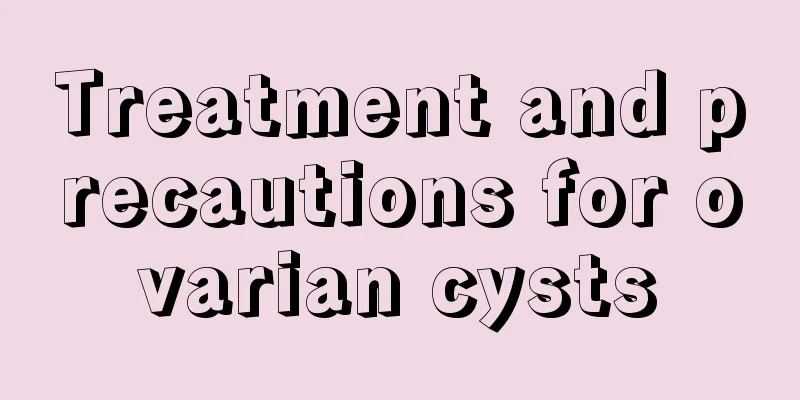Treatment of endometrial thickness 4mm

|
The problem of endometrium is undoubtedly a major focus of discussion nowadays. We have never stopped studying the problem of endometrium. This disease has brought great pain and torture to our lives, causing many people to suffer. Many couples cannot have a normal sex life, and the treatment is very inconvenient. So is there no way to cure this disease? The answer is obviously no, so what good methods are there to treat mild adenomyosis is undoubtedly a major focus of discussion now. Many of our older people may suffer from various diseases. This disease has brought great pain and torture to our lives and made many people suffer. For this reason, many people have sought medical treatment everywhere, but have not received good treatment results. We should realize the importance of solving this situation from the bottom of our hearts. Only by ensuring the health of the uterus can we have a normal sex life. So what is the treatment for endometrium 4mm? Let us learn about it together. Treatment: 1. Surgery Surgical treatment is the main method for endometriosis, because the scope and nature of the lesions can be basically determined under direct vision, it is more effective in relieving pain and promoting reproductive function, and the treatment course is short, especially for severe cases with more fibrosis and tight adhesions, which are not easily effective for drugs. For larger ovarian endometrioid cysts, drug treatment is ineffective and surgery may still preserve effective ovarian tissue. Surgery can be divided into three types: conservative surgery, semi-radical surgery and radical surgery. 2. Radiation therapy Although radiotherapy has been used for endometriosis for many years, the use of a variety of drugs and surgeries to achieve high therapeutic effects generally does not destroy ovarian function. The role of radiotherapy for endometriosis is to destroy ovarian tissue, thereby eliminating the effects of ovarian hormones and causing the ectopic endometrium to atrophy, achieving the purpose of treatment. Radiation does not have a significant destructive effect on ectopic endometrium, but for individual patients who cannot tolerate hormone treatment and whose lesions are located in the intestines, urinary tract and extensive pelvic adhesions, especially those with severe diseases such as heart, lung or kidney, and who are very afraid of surgery, external radiotherapy can be used to destroy ovarian function and achieve the treatment goal. Even for those who receive radiotherapy, a clear diagnosis must be made first, especially to avoid misdiagnosing malignant ovarian tumors as endometrial cysts, which may lead to incorrect treatment and delay correct treatment. 3. Hormone therapy 1. Danazol: It is a derivative of the synthetic steroid 17α-ethynyltestosterone. Its main function is to inhibit the production of GnRH in the hypothalamus, thereby reducing the synthesis and release of FSH and LH, leading to inhibition of ovarian function. It can also directly inhibit the synthesis of ovarian steroid hormones or competitively bind to estrogen and progesterone receptors, thereby leading to atrophy of the ectopic endometrium, anovulation and amenorrhea. 2. Nemestran: 3-Ethylenediol (R2323), a 19-nortestosterone derivative, has high anti-progestin activity and moderate anti-estrogen effect, inhibits the secretion of FSH and LH, reduces the estrogen level in the body, and causes the ectopic endometrium to shrink and absorb. 3. Gonadotropin-releasing hormone agonist (GnRHa): In 1982, Meldtum and Lemay reported that the application of LHRHa in the treatment of endometriosis achieved good results. LHRH has a biphasic effect on the pituitary gland. Large amounts of continuous use of LHRH cause pituitary cells to downregulate, that is, the pituitary cell receptors are filled with hormones and are unable to synthesize and release FSH and LH, thus playing a counter-regulatory role. Side effects include hot flashes, vaginal dryness, headache, and minor vaginal bleeding. The above content introduces us to the treatment method of endometrium 4mm. These contents are undoubtedly a great blessing to our patients. We can use the above methods to effectively treat our own problems. We can also tell the above article to our relatives and friends around us, so that more people can restore their health and reduce the distress caused by uterine problems. |
<<: What to do if you have bleeding two months after a cesarean section
>>: Microwave treatment of cervical erosion
Recommend
How to increase milk supply when milk suddenly stops flowing
Breastfeeding is the healthiest way to breastfeed...
What's going on with the bleeding?
Vaginal bleeding after sex is a common symptom am...
Threatened abortion gestational sac expulsion symptoms
Medical abortion is a method that many women woul...
What are the ways for women to nourish their kidneys?
Women need to go through several age stages in th...
Who can't have an abortion?
Artificial abortion is a good way to solve unexpe...
Thigh pain, why women
If we exercise suddenly, we will experience muscl...
Should pregnant women take DHA or Runkang?
Many pregnant women take nutritional supplements ...
"Affirmation" for vitamin D! People with vitamin D deficiency will have 229 genes affected
Vitamins are a type of nutrients that are essenti...
Do you need Chinese medicine to regulate your body before pregnancy?
We all know that many people nowadays, especially...
Can I use skin care products during breastfeeding?
Loving beauty is every woman’s nature. Even after...
How to choose pecans? Are pecans high in calories?
The aroma of walnut kernels is rich and refreshin...
Lochia wipes have a rancid smell
Lochia is a normal phenomenon for women in the po...
What are the dangers of high blood coagulation in pregnant women
Hypercoagulability during pregnancy is a relative...
How long does it take to get pregnant?
How long does it take to get pregnant during the ...









